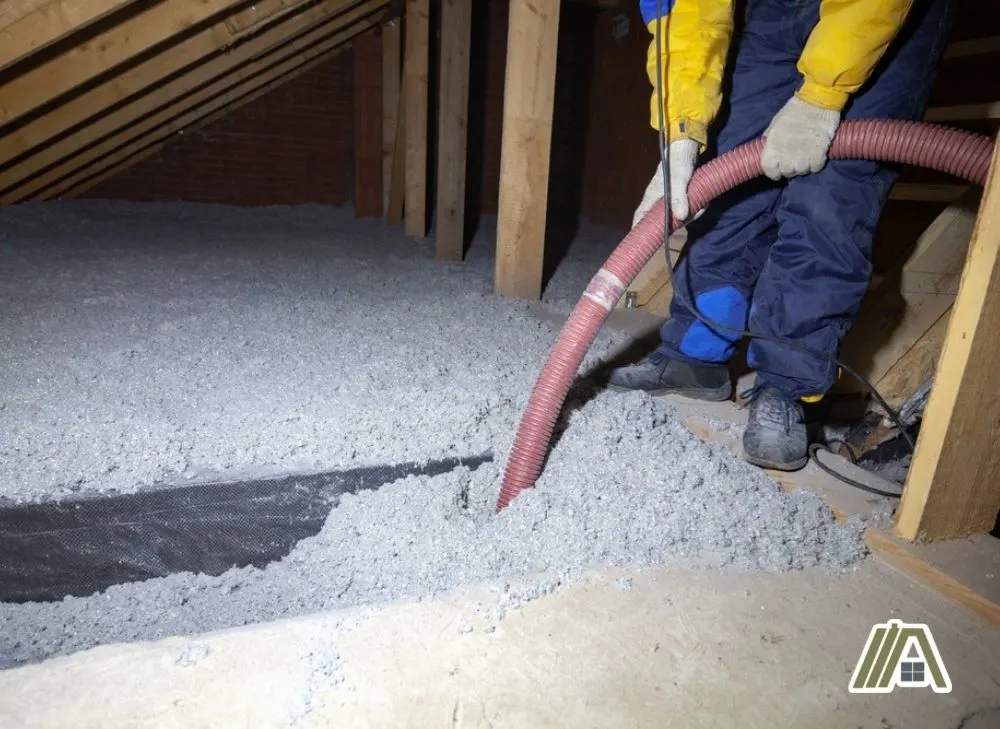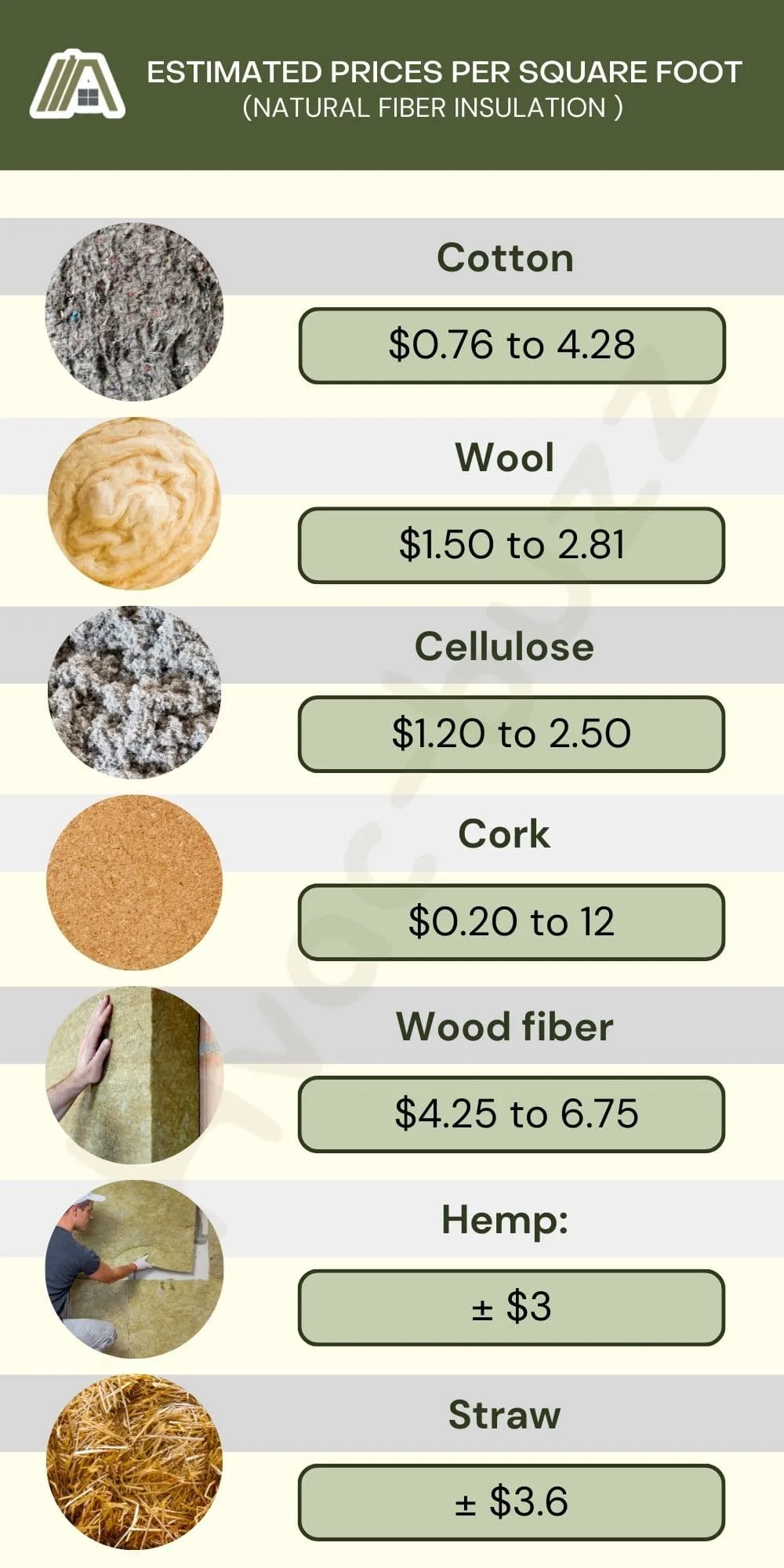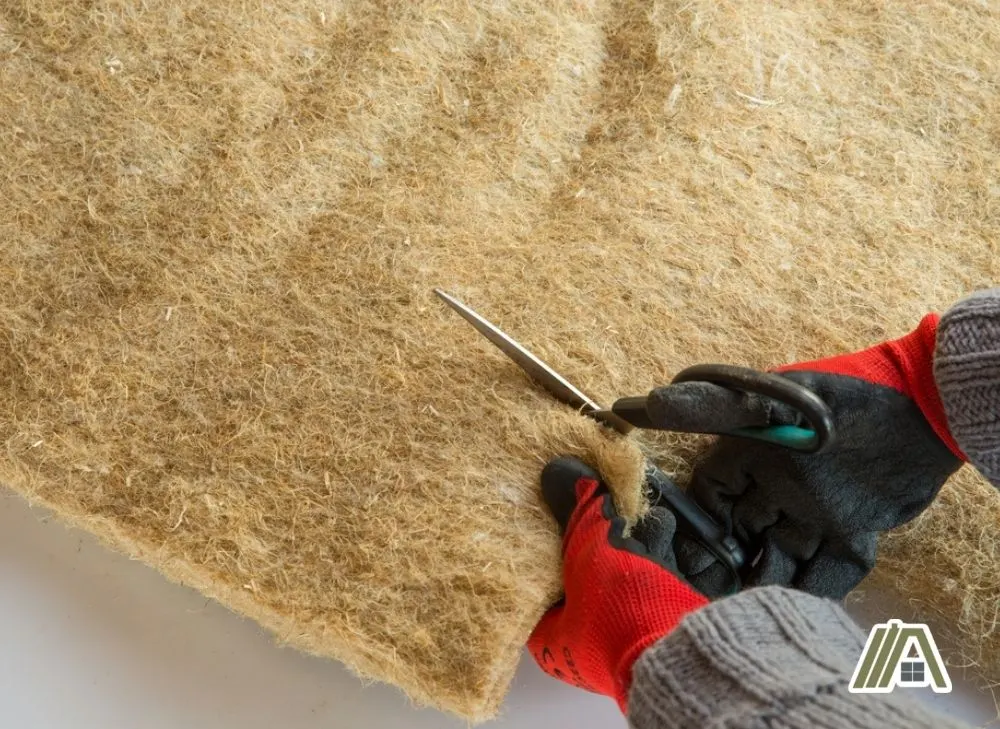As you become more aware of the importance of “going green” and making choices to conserve your health, you may consider alternatives to synthetically produced products, like insulation. They are available, although less well-known.
To help you make your decision, here we explain natural fiber insulation, including its costs, pros, and cons, so that you can be confident in your choice.

Cotton, sheep wool, straw, hemp, wood fibers, cellulose, and cork are available as natural insulation, coming in bales, batts, boards, and loose-fill. Inherent R-values range from 2-4.3 per inch, and cost ranges from $0.2-12 per sq. ft. Natural fiber insulation is much safer to use.
What Is Natural Fiber Insulation?
Natural fiber insulation is comprised of exactly what is in the name: natural fibers.
These natural fibers may be sourced from plant or animal materials.
Cotton insulation typically consists of 85% recycled cotton (often including recycled denim fibers) mixed with 15% plastic fibers.
Alternatively, batts of sheep wool or straw can form natural fiber insulation.
Other less common forms of natural insulation in the US are comprised of hemp and wood fibers.
Cork can be used, and cellulose (consisting of recycled newspaper) may also be considered as a type of natural fiber insulation.

These materials are often recycled and treated with chemicals such as borax to reduce the risk of fire, repel insects, and reduce mold buildup.
Under average conditions, such natural insulation materials can last several decades, but this depends on the location and climate of where it is installed.
Appearance and Use
Natural fiber insulation comes in various forms that look like the materials from which they are comprised.
Cotton insulation comes in batts that are often blue/gray in color, with fragments of cotton and denim visible. This is similar to cellulose insulation (also available as loose-fill and wet-spray), in which fragments of paper are visible.
Similarly, sheep’s wool is available in batts that are white, gray, or brown with a characteristic woolen appearance. It may also be used as loose-fill.
Straw may be used in bale form or fused into boards with heavyweight kraft paper covering each side.
Cork, hemp, and wood fiber insulation are also used as batts or rigid boards and are brown with textures characteristic of the materials.
Natural fiber insulation can be installed in the same way as synthetic insulation within floor, wall, and roof buildups.
Inherent R-Value of Natural Fiber Insulation
The R-value of a type of insulation determines how effective it is at preventing the transfer of heat. The higher the R-value, the more resistant it is to heat flow.
It is often the case that loose-fill insulation has a lower R-value than batts or boards of insulation.
Most synthetic insulation types have an R-value ranging from 2.5 to about 8 per inch of thickness.
The average R-values of common natural fiber insulation types range from about 2 to just over 4 per inch.
More specifically:
- Cellulose typically has R-values ranging from 3.2 to 3.8 per inch of thickness
- Sheep’s wool ranges from 3.6 to 4.3, depending on the form used
- Hemp and cork have similar average R-values of around 3.7 per inch
- Cotton is slightly higher at 3.8
- Straw has a lower R-value at just under 2 per inch.
Thickness Guide
To determine how thick insulation needs to be to obtain an R-rating, one can divide the target R-value by the R-value of the material.
The table below gives a range of the likely thicknesses of natural fiber insulation types needed to achieve different overall R-ratings.
| Inches of insulation required to fulfill R-value target |
Cost of Natural Fiber Insulation
For natural fiber insulation, there is a range of prices for each type of material, which vary greatly depending on the type used (blown-in vs. batt vs. boards, etc.).
The values provided here are a range of estimated prices for each type of natural fiber insulation per square foot:
- Cotton: $0.76 to 4.28
- Wool: $1.50 to 2.81
- Cellulose: $1.20 to 2.50
- Cork: $0.20 to 12
- Wood fiber: $4.25 to 6.75
- Hemp: ± $3
- Straw: ± $3.6

It is important to remember that even if a material might be cheaper per square foot, it might require much greater thicknesses to achieve the desired R-value, so consider this in your calculations.
- Use For Insulating, Cushioning, And Noise Dampening
- Safe Alternative - No Gloves, Face Mask, Or Goggles Needed
- Cut Or Rip To Fit Pipes And Ducts, Walls, And Much More
- Brand Name: Frost King
Last update on 2024-03-27 / Affiliate links / Images from Amazon Product Advertising API
Is It Easy to Install?
The ease of installation depends on the material and form used, but generally, installation can be easier in the sense that protective clothing and masks are not needed, and cleanup is simplified because the materials are biodegradable.
In batt form, insulation, such as sheep’s wool and cotton, can be quite simple to install as they can be cut and trimmed to shape as needed.
Blown-in forms, such as cellulose, can be installed using a suitable blower, but this may require more complex procedures to prevent settling and other unwanted effects.
Rigid board forms, such as cork, can be tricky to cut to fit around other areas with awkward angles.
Straw insulation can also be fairly easy to install, but this type of insulation may be best installed during house construction, and not necessarily during renovation.
Is Natural Fiber Insulation Dangerous?
Since natural fiber insulation is made from natural materials, it is much safer than synthetic insulating materials to use.
Although you might breathe in some fibers during installation, it is unlikely that this will cause major health issues, and certainly less so than synthetic insulating materials.
Some natural fiber insulating materials, such as hemp, can be quite flammable, but they are often treated with fire-retardant chemicals, including borax or ammonium sulfate, to minimize this risk.
While there may be concern that these fire-retardant chemicals themselves may be dangerous, there is little evidence to suggest this.
Sheep’s wool, hemp, or straw insulation may cause allergic responses in sensitive individuals during installation, but this is unlikely to be cause for major concern.
Benefits of Natural Fiber Insulation
Compared to other forms of insulation, natural fiber insulation types have several advantages.
Firstly, they are easier and safer to handle, without the requirement for major protective gear.
Secondly, they are environmentally friendly as they require little energy to produce since they are derived from recycled materials, result in low carbon dioxide emissions, and are biodegradable.

They can also provide soundproofing qualities (so you won’t have to suffer through the neighbor’s dreaded violin rehearsals) and provide electrical resistance.
Additionally, some types, such as sheep’s wool, can absorb moisture and reduce condensation and may improve indoor air quality by absorbing harmful gases.
Drawbacks of Natural Fiber Insulation
On the other hand, natural fiber insulation does have a few negative characteristics to consider.
While most natural fiber insulation types can last for a few decades, they are not as durable as synthetic insulation options.
Similarly, their ability to absorb moisture may make them more prone to damage and swelling.
They can be more flammable than other types of insulation (but if they are treated with fire-retardant chemicals, this shouldn’t be cause for concern).
Unfortunately, natural fiber insulations are often more expensive than other insulation types, and proper installation may require thicker walls.
Sources
https://www.energystar.gov/sites/default/files/asset/document/Insulation%20Fact%20Sheet.pdf
https://www.homebuilding.co.uk/advice/natural-insulation
https://becgreen.ca/sheeps-wool-insulation-in-batts-and-loose-fill/
https://www.energy.gov/energysaver/insulation-materials#natural
https://homeguide.com/costs/attic-insulation-cost
https://www.homewyse.com/costs/cost_of_cotton_insulation.html
https://renoquotes.com/en/blog/insulation-cost
https://www.bre.co.uk/filelibrary/pdf/projects/low_impact_materials/IP18_11.pdf https://naturalwool-insulation.com/portfolio/easy-to-install/

